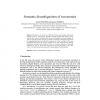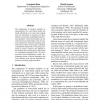281 search results - page 45 / 57 » Similarity-based Word Sense Disambiguation |
107
Voted
LREC
2010
15 years 1 months ago
2010
Conventional methods for disambiguation problems have been using statistical methods with co-occurrence of words in their contexts. It seems that human-beings assign appropriate w...
83
Voted
EMNLP
2009
14 years 10 months ago
2009
This paper presents a supervised method for resolving metonymies. We enhance a commonly used feature set with features extracted based on collocation information from corpora, gen...
101
Voted
COLING
2008
15 years 1 months ago
2008
Supervised approaches to Word Sense Disambiguation (WSD) have been shown to outperform other approaches but are hampered by reliance on labeled training examples (the data acquisi...
112
click to vote
CCIA
2007
Springer
15 years 6 months ago
2007
Springer
Polysemy is one of the most difficult problems when dealing with natural language resources. Consequently, automated ontology learning from textual sources (such as web resources) ...
107
Voted
EMNLP
2010
14 years 10 months ago
2010
The computation of meaning similarity as operationalized by vector-based models has found widespread use in many tasks ranging from the acquisition of synonyms and paraphrases to ...


